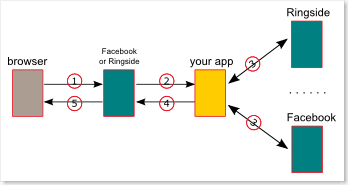(1) Can Ringside use applications of Facebook?
Generally not. To use applications of Facebook, one of the two requirements must be satisfied:
<1> You know the callback URL of the application.
If you know the callback URL, you can create a new application on Ringside serve which points to the same callback URL. However, as far as I know, you have no way to figure out the callback URLs of Facebook applications developed by others.
<2> Facebook exposes a "proxy URL".
In this case, Facebook does not need to expose callback URL of an application. Instead, Facebook acts as a Proxy server and sits between Ringside server and your app. Then you points "Callback URL" of your Ringside app at the Facebook "proxy URL". So the communication style is:
your Ringside app <=> Ringside server <=> Facebook <=> Facebook App.
Facebook is a relay station which connects Ringside server with Facebook applications. However, as far as I know, currently Facebook does not support the "proxy URL".
(2) Can Facebook use applications of Ringside?
Yes. Ringside supports the second method described above.
If you has built an application on a Ringside server and you want to that application to be accessed in Facebook, you should:
[*] add a new application in your Facebook account;
[*] copy configuration information of your Ringside app to the newly created app in Facebook.
[*] set Callback URL(in Facebook setting) to point to your Ringside app. Note: there is a specific format of "proxy URL" of apps in Ringside: http://ringside_server:port/trust.php/facebook/canvas_path. You should replace canvas_path with your real value. It should be the canvas path you set in Ringside server rather than Facebook.
Note that that app is run inside of backend Ringside server instead of Facebook. So the app generates all output based on information stored on backend Ringside server. For example, if the app returns a list of your friends, you will see friend list of the profile you set up on Ringside server. In other words, you will not see your Facebook friend list.
Architecture:
<1> browser sends request to Facebook
<2> Facebook sends request to "Callback URL" (format is: http://ringside_server:port/trust.php/facebook/canvas_path)
<3> Ringside server sends request to your app server
<4> Your app makes calls to Ringside server and integrates response into output
<5> Your app returns final output to Ringside server
<6> Ringside server passes the output to Facebook
<7> Facebook returns response to client.
One issue is: if response in step <5> contains FBML segment, who will render the FBML? Ringside server or Facebook? I guess Facebook renders FBML into HTML. In other words, Ringside server just acts as a pure proxy and it does not render inbound messages. Maybe I am wrong, I am not 100% sure about my guess.
(3) More possibilities
Actually, your app can makes use of all resources that you have privilege to access. No matter where you deploy your app, your app can makes API calls to Facebook, Ringside server and open social containers(e.g. Orkut, hi5...).
Architecture:

In this way, you can integrate different resources and produce better result.




No comments:
Post a Comment